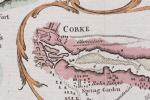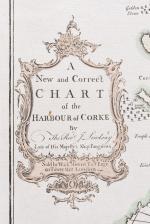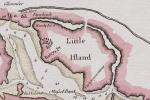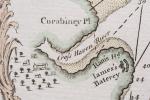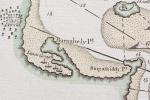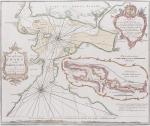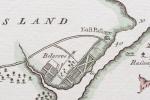Lindsay, [A New and Correct Chart of Cork Harbour] "A New and Correct Chart of t
[A New and Correct Chart of Cork Harbour (This is the rare 18th century Map of Cork Harbour which also shows Haulbowline Island, which is the original location of “The Royal Cork Yacht Club”, later “The Water Club of the Harbour of Cork”, the Map shows also the Old Head of Kinsale, Crosshaven Harbour, Haulbowline Island, Curraghbinny, Spike Island, Ringaskiddy etc.)] – Correct Title of the Map: “A New and Correct Chart of the Harbour of Corke by the Revd. J. Lindsay, Late of His Majesty’s Ship Fougueux”. There is an inset Map showing “A Continuation of Corke Harbour from a smaller Scale”. The scale of this reads “A Scale of three English”. Below the chart is a coastal profile entitled “A View of the Land from the Old Head of Kinsale to Hawks Rock, the Old Head W b S 7 Miles. Cork Harbour mark’d *. ″
Original, hand-coloured copper engraving on extra thick paper / Better paper – edition [differing from all other versions of this map we ever handled, this is only the second version of this high-quality version of this Map we encountered], possibly an admiralty issue since it was dedicated to the Office of the Lord High Admiral of Great Britain. London, Sold by W. & I. Mount, T. & T. Page on Tower Hill, [c. 1759]. Beautifully mounted and framed. Size of the actual map: c. 62 cm wide x 52 cm high. Spectacular, unusually excellent condition of this rare, hand-coloured seachart of Cork Harbour with the Old Head and clear geography of Little Island, Poor Head, Ringaskiddy, Cork’s Natural Harbour, Crosshaven, Haulbowline, Spike Island, Cloyne, etc. / Price includes worldwide free shipping per UPS Courier !
The inset Map “A Continuation of Corke Harbour from a smaller Scale” shows the region in greater detail. This inset Map even shows details of Cork City with Ballintemple and its Spring Garden, Blackrock, Glancalain, Doundaniel, Douglas, Ronan’s Court, Mariebureagh [Maryborough], Red Island, Little Island, Horsehead with a longer Message on the Map about the location south of Horsehead reading: “Passage where great ships ride; Its good Ground and very convenient for Building of Ships”, Further East on the Inset-Map we can see Carickhowell Castle, Midleton with a message on the map: “lately Built and made a Port Town by Sir John Brodrick” also showing “Part of Sir John Brodricks Park”, Ballyourdock, Ballnacor, Road to Youghal / To the south of the Inset-Map we see Ashgrove and a larger Message / “Note” for Sailors and Navigators to “Be careful to avoid having Roches Tower & Dog’s Nose in one; for without the Tower, in that line, there is a small Rock, which will take you up at 23 feet water, with 7 fathom round it. The Figures [on this Map] shew the depth in feet at low Water”.
The Map also shows Monks Castle, Monks Creek (Monkstown Area, Ballybricken with Barnahely Point and “Leane Ceragh”) and “Cove Town” which was later Queenstown and is today’s “Cobh”, whowing the “Road to West Passage” [today “Passage West”] and “East Passage”.
The larger Map of Cork’s Natural Harbour goes all the way to Ballycotton and the Map also shows “Rostellan” the seat of William McWilliam O’Brien, 4th Earl of Inchiquin, 9th Baron Inchiquin, the Founder of the Royal Yacht Club. He was the son of William MacWilliam O’Brien, 8th Baron of Inchiquin, 3rd Baron O’Brien of Burren, 3rd Earl of Inchiquin.
Dedication on the Map reads: “To the Right Honorable George Lord Anson, Right Honorable Edward Boscarven, George Hay, Thomas Orby Hunter, Esq., Gilbert Elliott, Esq., Honorable John Forbes, Esq., Hans Stanley, Esq., Lords Commissioners for executing the Office of Lord High Admiral of Great Britain. This Chart is most humbly dedicated by their Lordships most obedient servant. John Lindsay.″
FRom a Blog on the UCC – Website: “We first know of the Rev. John Lindsay as chaplain in the Royal Navy in 1755 and by 1757 he was chaplain on H.M.S. Fougueux (64 guns, 500 men). The chart of Cork is based on a survey started in 1757 when H.M.S. Fougueux was in Cork for a period. Lindsay had noticed that the old charts were “laid down by the antient rule of thumb and even in that way itself finished in a very bungling manner” (Voyage 13). When H.M.S. Fougueux returned to Cork as part of an expedition to French West Africa in 1758 Lindsay completed the chart. The chart was first published in “A Voyage to the Coast of Africa in 1758” (1759). (Source: UCC – Blog)
- Keywords: 18th Century · 18th Century – Rare · 18th Century Map · 18th Century Maps · Catalogue No.5 – Maps of the World · Cork · Cork City · Cork Harbour · Cork History · Crosshaven · Maps of County Cork · Maps of Ireland · Old Head of Kinsale · Old Maps · Sea Chart · Vintage Map · WCBF Highlight · West Cork Rare Book Fair 2022
- Language: English
- Inventory Number: 100117AG
EUR 1.800,--
© 2025 Inanna Rare Books Ltd. | Powered by HESCOM-Software







